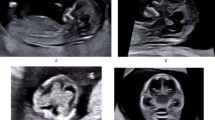Abstract
Background
Macrocephaly is a common finding in infants and is often idiopathic or familial. In the absence of clinical signs and symptoms, it can be difficult to determine when concern for underlying pathology is justified.
Objectives
The objectives of this study were to determine the utility of screening head ultrasound (US) in asymptomatic infants with macrocephaly and to identify clinical factors associated with significant US findings.
Materials and methods
A 20-year retrospective review was performed of infants undergoing head US for macrocephaly or rapidly increasing head circumference. Data collected included age, gender, head circumference at birth and at the time of US, specialty of the ordering physician, US findings, computed tomography (CT) or magnetic resonance imaging (MRI) findings, and clinical course including interventions.
Results
Four hundred and forty infants met inclusion criteria. Two hundred and eighty studies (64%) were found to be normal, 137 (31%) had incidental findings, 17 (3.8%) had indeterminate but potentially significant findings, and 6 (1.4%) had significant findings. Twenty of the 23 infants with indeterminate or significant findings had subsequent CT or MRI. This confirmed significant findings in eight infants (1.8%): three subdural hematomas, two intracranial tumors, two aqueductal stenoses, and one middle fossa cyst. Five of the eight infants required surgical procedures. The only statistically significant association found with having a significant finding on head US was head circumference at birth.
Conclusion
Ultrasound is a useful initial study to evaluate infantile macrocephaly, identifying several treatable causes in our study and, when negative, effectively excluding significant pathology.









Similar content being viewed by others
References
Orrù E, Calloni SF, Tekes A et al (2018) The child with macrocephaly: differential diagnosis and neuroimaging findings. AJR Am J Roentgenol 210:848–859
Tan AP, Mankad K, Gonçalves FG et al (2018) Macrocephaly: solving the diagnostic dilemma. Top Magn Reson Imaging 27:197–217
Medina LS, Frawley K, Zurakowski D et al (2001) Children with macrocrania: clinical and imaging predictors of disorders requiring surgery. AJNR Am J Neuroradiol 22:564–570
Babcock DS, Han BK, Dine MS (1988) Sonographic findings in infants with macrocrania. AJR Am J Roentgenol 150:1359–1365
Carolan PL, McLaurin RL, Towbin RB et al (1985) Benign extra-axial collections of infancy. Pediatr Neurosci 12:140–144
Kuruvilla LC (2014) Benign enlargement of sub-arachnoid spaces in infancy. J Pediatr Neurosci 9:129–131
Marino MA, Morabito R, Vinci S et al (2014) Benign external hydrocephalus in infants: a single Centre experience and literature review. Neuroradiol J 27:245–250
American College of Radiology, American Institute of Ultrasound in Medicine, Society for Pediatric Radiology, Society of Radiologists in Ultrasound (2019) ACR-AIUM-SPR-SRU Practice parameter for the performance of neurosonography in neonates and infants (Revised 2019). https://www.acr.org/-/media/ACR/Files/Practice-Parameters/Neurosonog.pdf. Accessed 26 May 2020
Smith R, Leonidas JC, Maytal J (1998) The value of head ultrasound in infants with macrocephaly. Pediatr Radiol 28:143–146
Haws ME, Linscott L, Thomas C et al (2017) A retrospective analysis of the utility of head computed tomography and/or magnetic resonance imaging in the management of benign macrocrania. J Pediatr 182:283–289. e281
Naffaa L, Rubin M, Stamler AC et al (2017) The diagnostic yield of ultrasound of the head in healthy infants presenting with the clinical diagnosis of benign macrocrania. Clin Radiol 72:94.e7–94.e11
Sampson MA, Berg AD, Huber JN, Olgun G (2019) Necessity of intracranial imaging in infants and children with macrocephaly. Pediatr Neurol 93:21–26
Author information
Authors and Affiliations
Corresponding author
Ethics declarations
Conflicts of interest
None
Additional information
Publisher’s note
Springer Nature remains neutral with regard to jurisdictional claims in published maps and institutional affiliations.
Rights and permissions
About this article
Cite this article
Thomas, C.N., Kolbe, A.B., Binkovitz, L.A. et al. Asymptomatic macrocephaly: to scan or not to scan. Pediatr Radiol 51, 811–821 (2021). https://doi.org/10.1007/s00247-020-04907-7
Received:
Revised:
Accepted:
Published:
Issue Date:
DOI: https://doi.org/10.1007/s00247-020-04907-7




